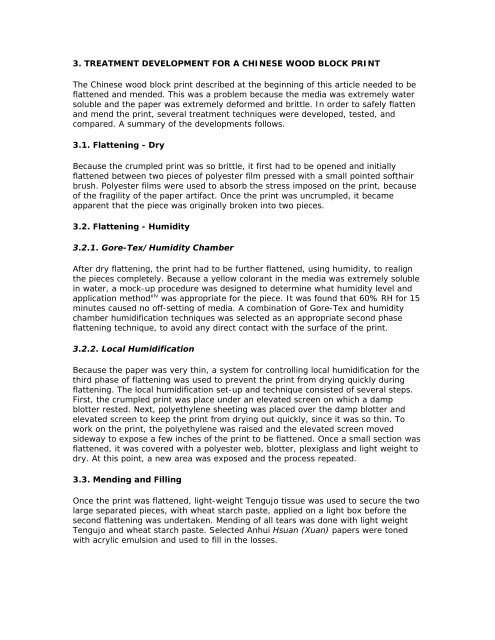technology, treatment, and care of a chinese wood block print
technology, treatment, and care of a chinese wood block print
technology, treatment, and care of a chinese wood block print
Create successful ePaper yourself
Turn your PDF publications into a flip-book with our unique Google optimized e-Paper software.
3. TREATMENT DEVELOPMENT FOR A CHINESE WOOD BLOCK PRINT<br />
The Chinese <strong>wood</strong> <strong>block</strong> <strong>print</strong> described at the beginning <strong>of</strong> this article needed to be<br />
flattened <strong>and</strong> mended. This was a problem because the media was extremely water<br />
soluble <strong>and</strong> the paper was extremely deformed <strong>and</strong> brittle. In order to safely flatten<br />
<strong>and</strong> mend the <strong>print</strong>, several <strong>treatment</strong> techniques were developed, tested, <strong>and</strong><br />
compared. A summary <strong>of</strong> the developments follows.<br />
3.1. Flattening - Dry<br />
Because the crumpled <strong>print</strong> was so brittle, it first had to be opened <strong>and</strong> initially<br />
flattened between two pieces <strong>of</strong> polyester film pressed with a small pointed s<strong>of</strong>thair<br />
brush. Polyester films were used to absorb the stress imposed on the <strong>print</strong>, because<br />
<strong>of</strong> the fragility <strong>of</strong> the paper artifact. Once the <strong>print</strong> was uncrumpled, it became<br />
apparent that the piece was originally broken into two pieces.<br />
3.2. Flattening - Humidity<br />
3.2.1. Gore-Tex/Humidity Chamber<br />
After dry flattening, the <strong>print</strong> had to be further flattened, using humidity, to realign<br />
the pieces completely. Because a yellow colorant in the media was extremely soluble<br />
in water, a mock-up procedure was designed to determine what humidity level <strong>and</strong><br />
application method xlv was appropriate for the piece. It was found that 60% RH for 15<br />
minutes caused no <strong>of</strong>f-setting <strong>of</strong> media. A combination <strong>of</strong> Gore-Tex <strong>and</strong> humidity<br />
chamber humidification techniques was selected as an appropriate second phase<br />
flattening technique, to avoid any direct contact with the surface <strong>of</strong> the <strong>print</strong>.<br />
3.2.2. Local Humidification<br />
Because the paper was very thin, a system for controlling local humidification for the<br />
third phase <strong>of</strong> flattening was used to prevent the <strong>print</strong> from drying quickly during<br />
flattening. The local humidification set-up <strong>and</strong> technique consisted <strong>of</strong> several steps.<br />
First, the crumpled <strong>print</strong> was place under an elevated screen on which a damp<br />
blotter rested. Next, polyethylene sheeting was placed over the damp blotter <strong>and</strong><br />
elevated screen to keep the <strong>print</strong> from drying out quickly, since it was so thin. To<br />
work on the <strong>print</strong>, the polyethylene was raised <strong>and</strong> the elevated screen moved<br />
sideway to expose a few inches <strong>of</strong> the <strong>print</strong> to be flattened. Once a small section was<br />
flattened, it was covered with a polyester web, blotter, plexiglass <strong>and</strong> light weight to<br />
dry. At this point, a new area was exposed <strong>and</strong> the process repeated.<br />
3.3. Mending <strong>and</strong> Filling<br />
Once the <strong>print</strong> was flattened, light-weight Tengujo tissue was used to secure the two<br />
large separated pieces, with wheat starch paste, applied on a light box before the<br />
second flattening was undertaken. Mending <strong>of</strong> all tears was done with light weight<br />
Tengujo <strong>and</strong> wheat starch paste. Selected Anhui Hsuan (Xuan) papers were toned<br />
with acrylic emulsion <strong>and</strong> used to fill in the losses.
















